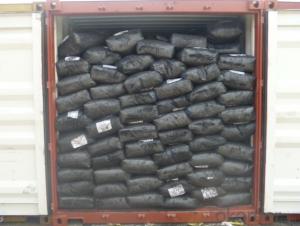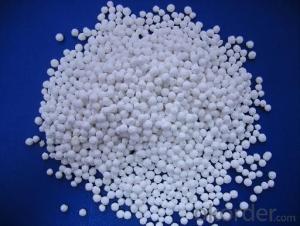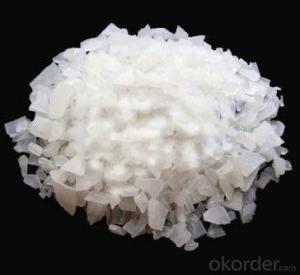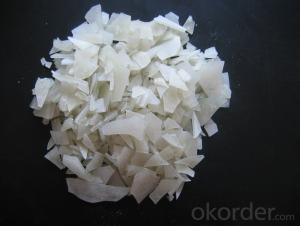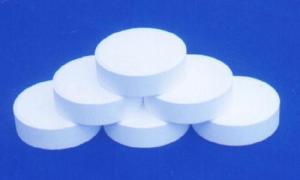Aluminum Sulfate for water treatment with MSDS and SGS test report
- Loading Port:
- Qingdao
- Payment Terms:
- TT OR LC
- Min Order Qty:
- 25 m.t.
- Supply Capability:
- 12000 m.t./month
OKorder Service Pledge
OKorder Financial Service
You Might Also Like
1. Chemical and Physical Properties:
Product name: Aluminium Sulphate or Aluminum Sulfate
Shape: Flakes or Granular or Powder.
EINECS NO.:233-135-0
CAS No.: 10043-01-3
HS.Code: 28332200
Molecular Formula: Al2(SO4)3
Appearance:It is white or grey flake,particle or massive crystallization.
Apt to cake after moisture absorption when laid in air for a long time.A little green because of Fe2+ ,yellow when Fe2+ is oxided to Fe3+.Soluble in water easily,and water solution is acid.
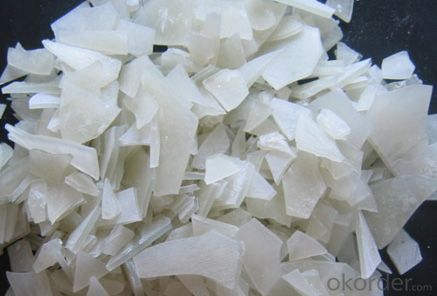
2. Specification:
Standard: HG/T 2225-2001 and HG/T 2227-2004
Items | Specifications | |||
I Type:Low Ferrous/Low Iron | II Type:Non-Ferrous/Iron-free | |||
First Class | Qualified | First Class | Qualified | |
Al2O3 % ≥ | 15.8 | 15.6 | 17 | 16 |
Ferrous(Fe )% ≤ | 0.5 | 0.7 | 0.005 | 0.01 |
Water Insolube % ≤ | 0.1 | 0.15 | 0.1 | 0.15 |
PH (1% aqueous solution) ≥ | 3.0 | 3.0 | 3.0 | 3.0 |
Arsenic(As) %≤ | 0.0005 | 0.0005 | ||
Heavy metal (Pb) %≤ | 0.002 | 0.002 | ||
3.Applications:
Water effluent treatment system
It's used for purification of drinking water and wastewater treatment by settling of impurities by
means of precipitation and flocculation.
Paper Industry
It helps in sizing of paper at neutral and alkaline pH, thus improving paper quality (reducing spots
and holes and improving sheet formation and strength) and sizing efficiency.
Textile Industry
It is used for color fixing in Naphthol based dyes for cotton fabric.
Other Uses
Leather tanning, lubricating compositions, fire retardants; decolorizing agent in petroleum, deodorizer; food additive; firming agent; dyeing mordant; foaming agent in firefighting foams; fireproofing cloth; catalyst; pH control; waterproofing concrete; aluminum compounds, zeolites etc.
4. Package:
Packaging Detail: PP/PE 50kg/bag;25kg/bag;Jumbo bag or according to customers' requirements.
20-25MT will be loaded in per 20'FCL container.
5. Attention and Storage:
The product is liable to absorb moisture and clot due to long-term exposure, so shady, cool and ventilated environment is needed.
FAQ:
Why choose us
♦ Quality Control
Well equipped in-house laboratory for checking and testing of all inputs and outputs to meet highest level of quality standards.
♦ Customised Packaging
We offer a variety of packaging options to suit your company and regulatory requirements, including customised
labelling.
♦ Specialist Transportation
We utilize an extensive network of proven contract carriers to make sure timely delivery and documentation.
♦ We Hold Stock, so you don't have to
Our extensive warehousing and distribution facility means we can store your products for you
- Q: What are the catalysts for making oxygen in chemistry? (At least 8 listed)
- Manganese dioxide, iron oxide (red brick powder), copper oxide, ferrous oxide, iron oxide, activated carbon, egg shell, fresh liver, raw potato chips, etc.
- Q: how could scientists know the exact catalyst for every reactions??? THANX sooo much
- Believe me, nema, there's no way that we chemists know the best catalyst for every reaction. That would be simply impossible. However, from the type of reaction, the reactants, products, reaction conditions, solvents, etc. and from one's experience and the literature (papers and patents) one can get a good idea for most reactions of the type of catalyst that has worked for similar systems. One then starts off with a catalyst from the literature and modifies or changes it if improvement is needed based on chemical principles that one learns. There are also some theoretical calculations that can be made. Sometimes they work and sometimes they don't :) If it is an industrially important process like the Haber process for making ammonia from nitrogen gas and hydrogen gas, there may be thousands of catalysts which have been tried and evaluated. New minor improvements are being made every day. When a company does find a very good catalyst for an important reaction, often they keep it a trade secret. The good catalyst can make a huge difference in how commercially successful a particular process is. That's a large part of what chemical engineers do. You may never know if you have the best catalyst. The most you can hope for is one that is good enough. So it's a few parts personal knowledge, a few parts literature, a couple of parts theory, a lot of experimentation and often, more than not, a little luck. :)
- Q: Also, how is the catalyst affected by heat? Please answer all of the questions not just one of the three. THANK YOU!
- The catalyst is affected by vinegar because vinegar is acidic meaning there are more H+ ions. This alters the charges on the R groups of the amino acid residues of the enzyme molecule. The bonds that help maintain the conformation of the enzyme molecule which is ionic will therefore, be disrupted and the binding of substrate will be affected. However, if pH is restored to optimum pH, the maximum activity of the enzyme will be restored but this is only if the pH was only altered by a small extent. If pH is altered by a large extent, the conformation of the enzyme molecule will be severely affected causing it to denature. The catalyst is affected by heat because excessive heat disrupts the intermolecular bonds which stabilise the secondary and tertiary structure of an enzyme molecule(the enzyme molecule has a tertiary structure). The enzyme molecule unfolds and the precise shape of the active site is lost. This loss of structure and function is irreversible.
- Q: What is chemical adsorption and its relationship with heterogeneous catalysis
- The catalytic cycle includes five steps: diffusion, chemical adsorption, surface reaction, desorption and reverse diffusion.The chemical adsorption is an important part of the heterogeneous catalysis process, and the adsorption of the reactants on the catalyst surface,
- Q: What is the difference between an enzyme catalyst in a living body and a catalyst in chemistry?
- enzyme susceptibility inactivation Chemical catalyst under certain conditions, due to poisoning and loss of catalytic capacity; and enzyme than the chemical catalyst is more fragile, more volatile activity. Any factor that makes the protein degenerate (to strengthen the acid, alkali, high temperature, etc.), can make the enzyme completely lost activity.
- Q: What are the methods of catalyst characterization?
- Physical means, is commonly used detection means, infrared, ultraviolet, electron microscopy, X-ray diffraction, nuclear magnetic, etc., of course, including a variety of conventional inability analysis.
- Q: Hydrogen and nitrogen in the high temperature and pressure and catalyst conditions for the synthesis of ammonia chemical equation
- 3H2 + N2 = 2NH3 conditional catalyst
- Q: In biology, the enzyme seems to be a tool for opening a reaction, such as the decomposition of cellulose, such as linked RNA and protein, no enzyme can not. But in chemistry, the catalyst is only a regulatory role, change the reaction rate only. The teacher said that the enzyme is the catalyst. Is there any other effect of the enzyme? (Ignorant high three dogs, you do not spray the big god)
- In fact, the chemical reaction is from the substrate (S) to the product (P). The chemical reaction is from the substrate (S) to the product (P). The chemical reaction is from the substrate (S) to the product (P) the process of. However, there is a free energy barrier between S and P, and in the absence of a catalyst, it is difficult to step through it and will pull something about it. Or understood to want you to jump 3 meters high, it is simply to life.
- Q: how do catalysts help in green chemistry?
- Catalysts reduce the energy barrier for reactions, meaning they require less energy to make the forward reaction go. This means less heat, light, or other energy sources are required to perform the same reaction without a catalyst. Also, by definition, a catalyst is not consumed in a reaction and can therefore be recycled many many times before replacement is necessary.
- Q: Will the catalyst decompose during the reaction between two substances? Exp:the decomposition of hydrogen peroxide.Will the manganese 4 oxide decompose?
- Catalysts are not used/destroyed in any reactions, it merely speeds up the process by lowering the reaction activation energy. It functions by being able to weaken or break the required bonds necessary in the chemical reaction (thus lowering activation energy) through temporary and weak bonding to form a complex. In this case the H2O2 molecule will bind with the MnO2 molecule due to the complimentary sites (thus forming a complex) to weaken the bonds for decomposition, but after decomposition the products (oxygen and water molecules) break off from the catalyst (as there are no more complementary sites with them) thus the catalyst will not be destroyed.
Send your message to us
Aluminum Sulfate for water treatment with MSDS and SGS test report
- Loading Port:
- Qingdao
- Payment Terms:
- TT OR LC
- Min Order Qty:
- 25 m.t.
- Supply Capability:
- 12000 m.t./month
OKorder Service Pledge
OKorder Financial Service
Similar products
Hot products
Hot Searches
Related keywords
















